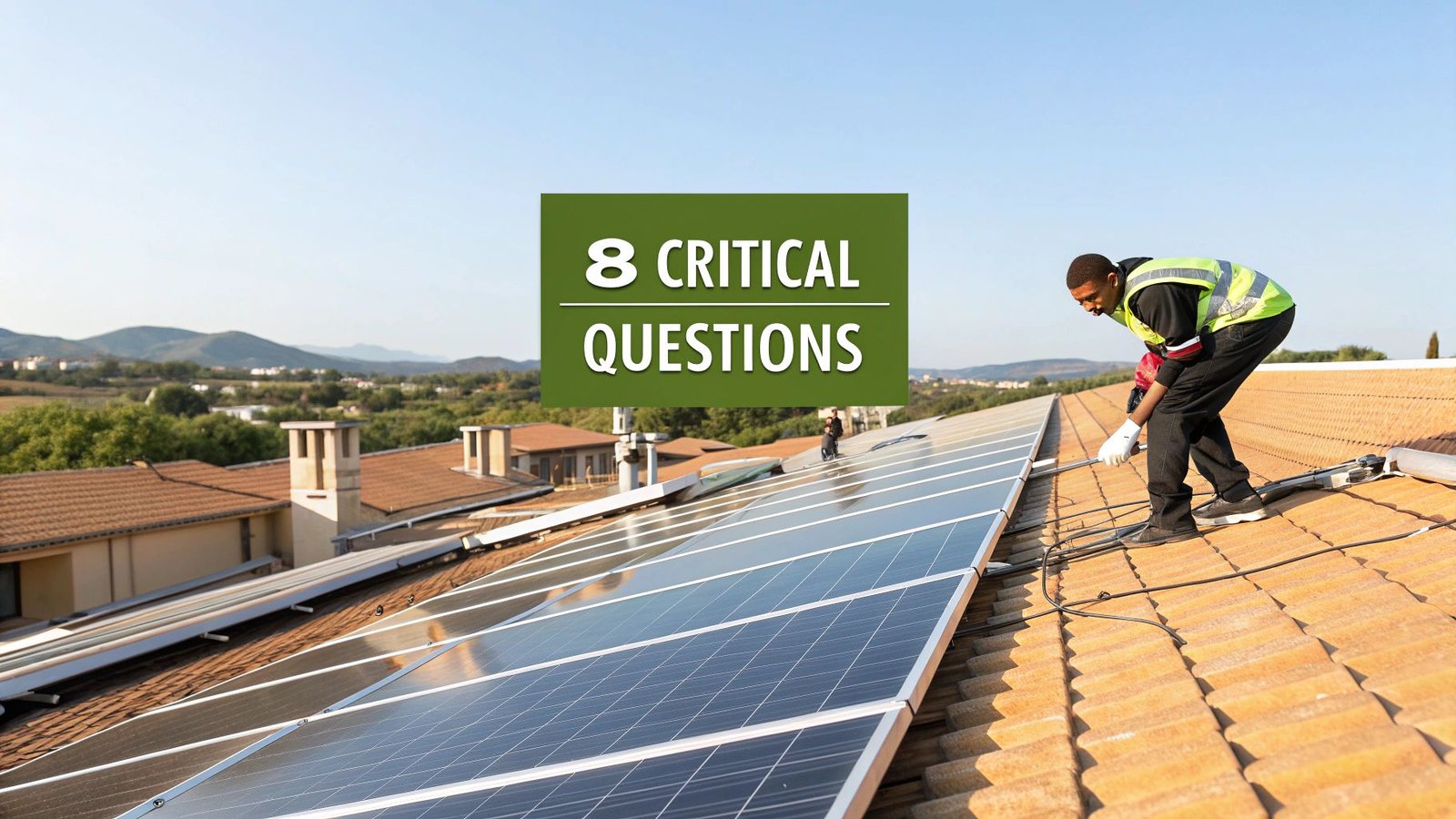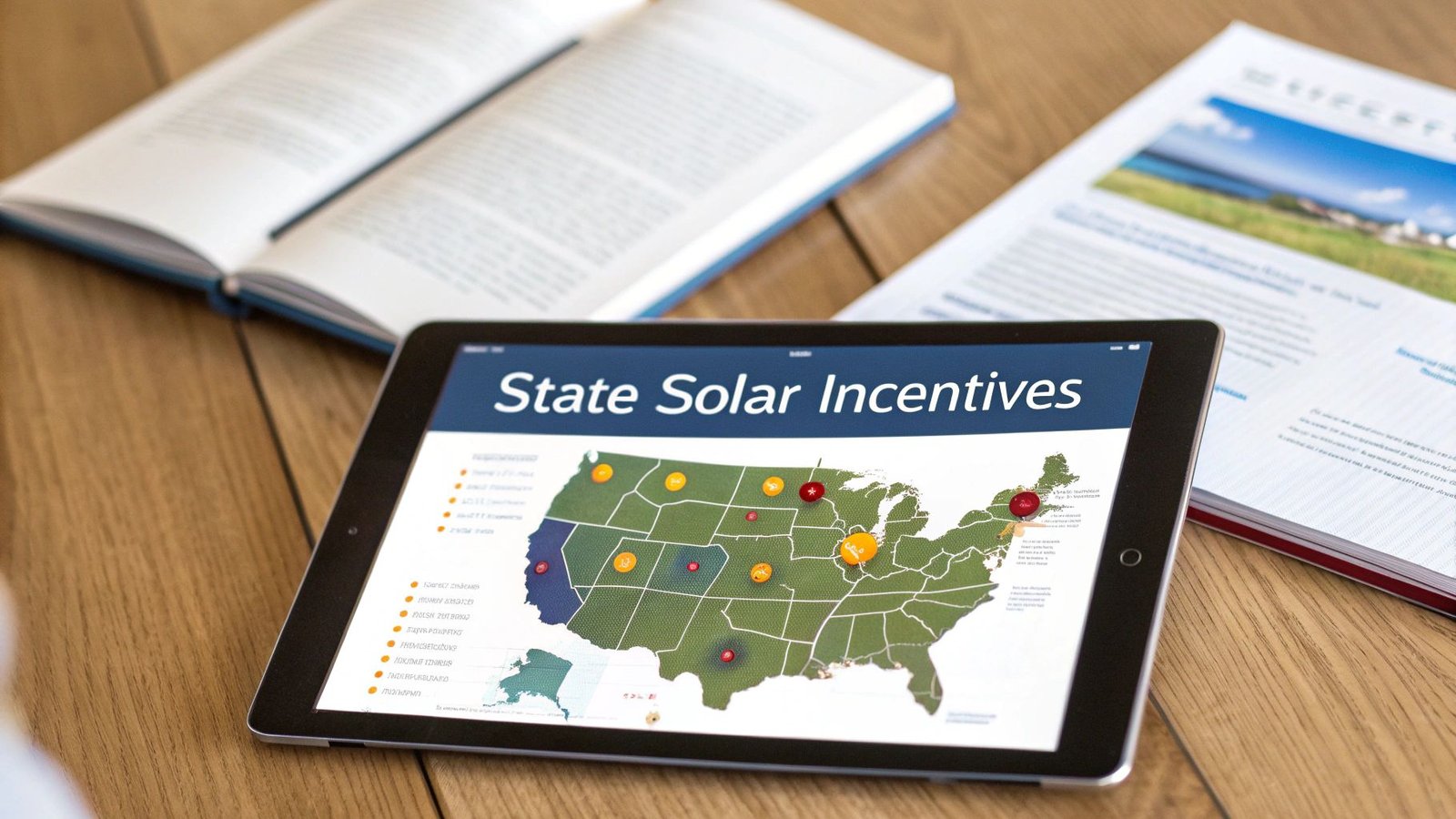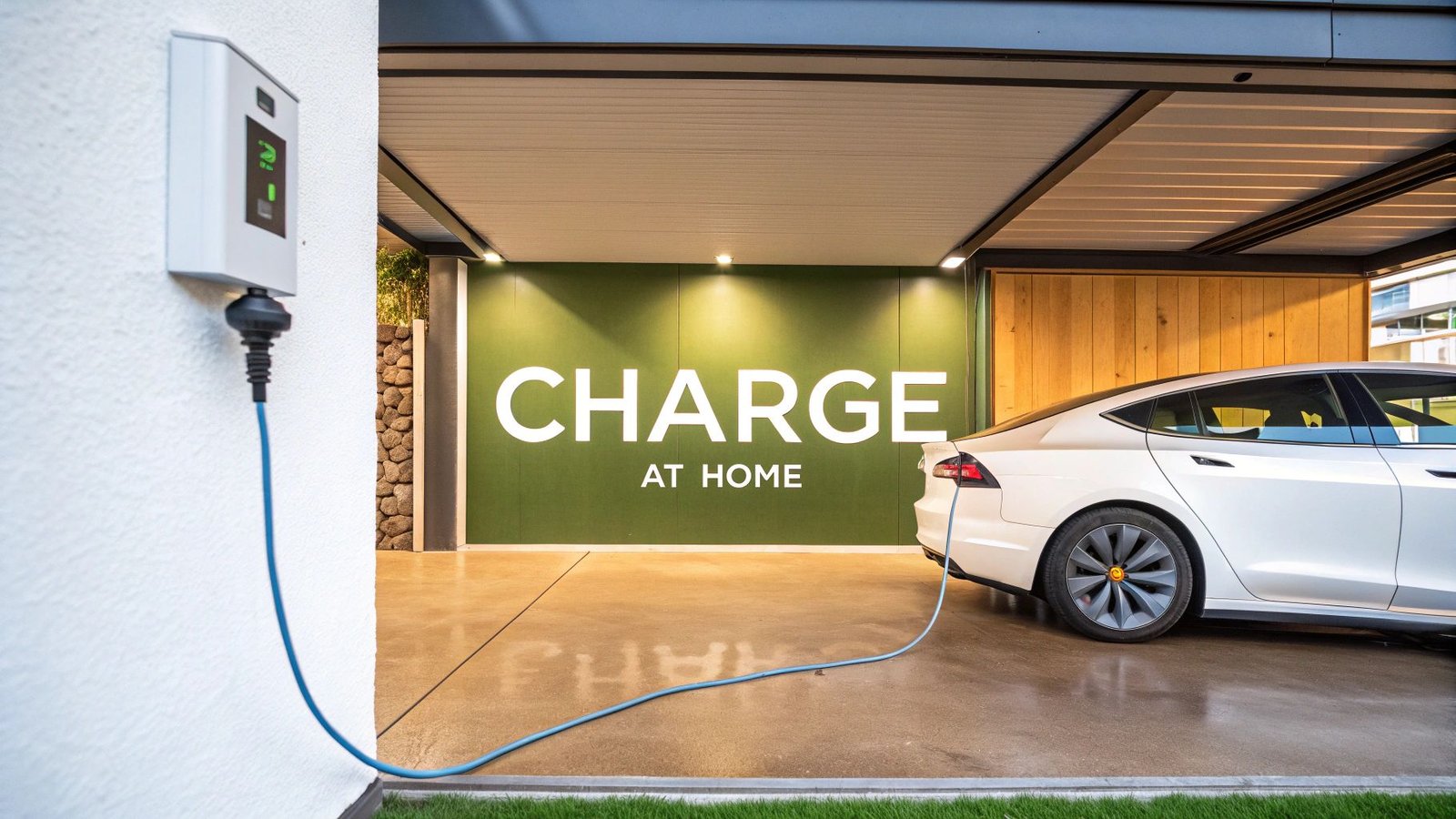So, you're wondering how much it really costs to go solar. Let's get straight to the point. The average cost for a home solar panel system in the U.S. typically runs between $24,000 and $36,000.
Think of that as the starting line. The final price tag will shift based on the size of your system, the quality of the equipment you choose, and even your zip code.
Your Quick Guide To Solar Panel System Costs
Buying a solar panel system is a bit like buying a car. You've got your base model, but then there are all the upgrades and options that influence the final cost. High-efficiency panels are like the premium trim level, while your system's total power output is like choosing the engine size. On top of that, you have professional installation and local permits, which are like the dealer fees of the solar world.
This overview will give you a quick, easy-to-understand starting point. As we go, we'll break down every single cost component so you can see exactly where your money is going.
Breaking Down The Numbers
In the United States, the price you pay for solar isn't just about the hardware. The average cost to have a professional install a single solar panel is about $1,200, which works out to roughly $2 to $3 per watt. This is often a bit higher than what you might see in other countries, thanks to factors like tariffs, permitting hassles, and financing costs.
For a really detailed look at the hands-on process and all the factors that can affect your final bill, check out a comprehensive guide to installing solar panels on your roof.
To put it all into perspective, here's a quick look at what you can expect to pay for a typical residential system before any of the awesome rebates or tax credits kick in.
Key Takeaway: Remember, the sticker price is just one piece of the puzzle. Your actual out-of-pocket cost will be much lower after you factor in the federal tax credits and local incentives we’ll cover later.
Average Residential Solar System Cost At A Glance
This chart provides a quick summary of estimated costs for a typical residential solar panel system in the U.S. before any incentives are applied.
graph TD
subgraph Average Total Cost (Pre-Incentives)
A[6 kW System] --> B[~ $24,000]
C[10 kW System] --> D[~ $36,000]
end
subgraph Cost Per Watt
E[Average] --> F[$2.50 - $3.50]
end
subgraph Cost Per Panel (Installed)
G[Average] --> H[$1,000 - $1,400]
end
These numbers give you a solid ballpark figure to start with. In the next sections, we'll unpack what drives these costs up or down.
Breaking Down the Price of Your Solar System
Getting a solar quote can feel a lot like looking at a car's sticker price—it’s just one big number. But just like a car is more than an engine and four wheels, a solar system is a collection of critical parts working in harmony. To really understand what you're paying for, we need to pop the hood and look at the individual components that make up the total cost of a solar panel system.
The most obvious part of your investment is the hardware itself. This is the tangible equipment—the panels on your roof, the inverter on your wall—that will be powering your home for the next 25-plus years.
This infographic gives a great high-level view of all the different cost factors that go into a residential solar project.
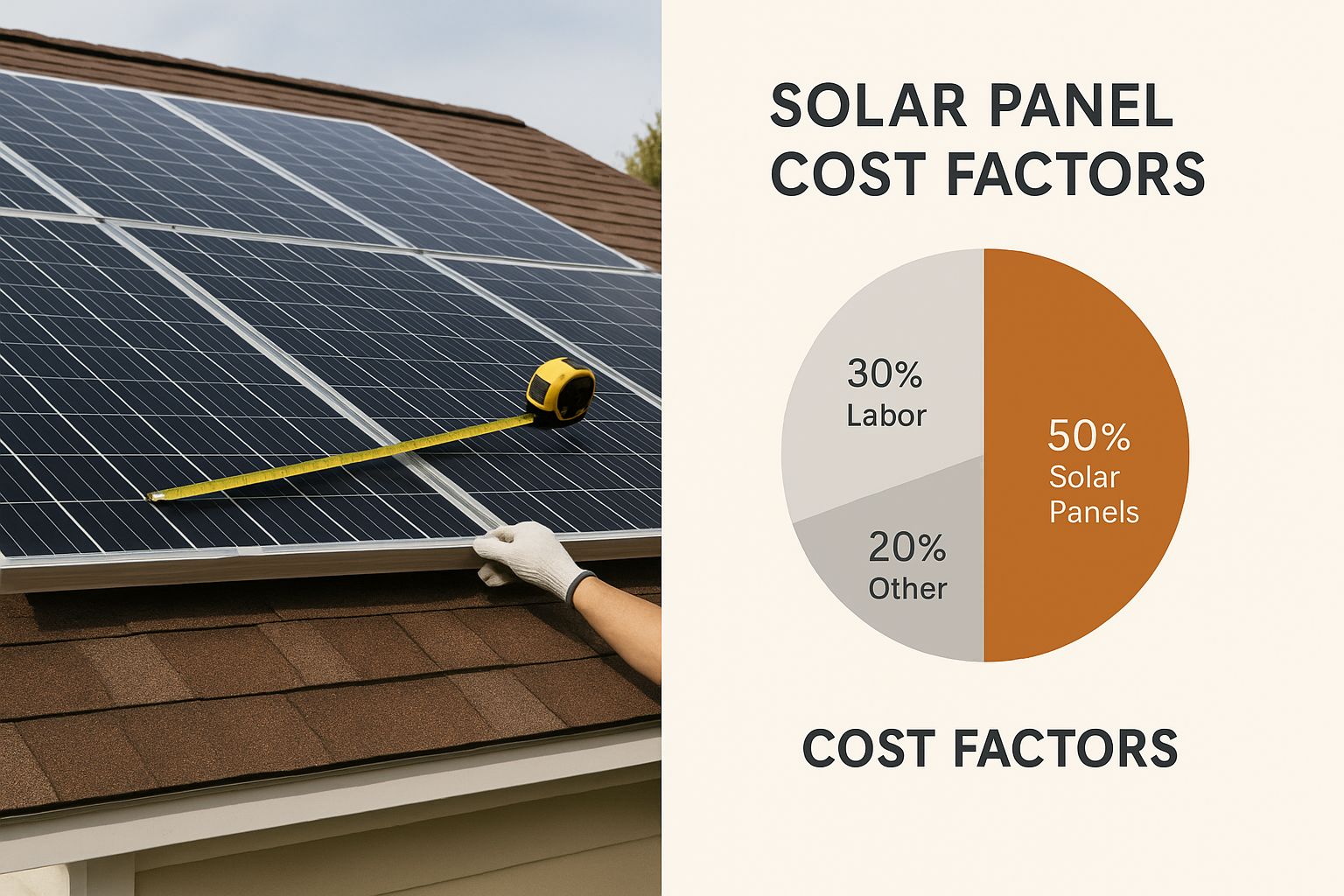
As you can see, the physical gear is just one piece of a much larger puzzle. The final price also includes everything from the crew's labor to the local permits required to get the system up and running.
The Key Hardware Components
So, what exactly are the main pieces of equipment you’re buying? Each plays a specific role, and its quality and technology level directly affect both the system's performance and its price tag.
- Solar Panels: The stars of the show. Panel prices vary widely based on their efficiency and the brand behind them. High-efficiency monocrystalline panels cost a bit more but are perfect for smaller roofs because they generate more power in less space. Polycrystalline panels, on the other hand, are a more budget-friendly option.
- Inverters: This is the brains of the entire operation. It's a crucial device that converts the direct current (DC) electricity your panels produce into the alternating current (AC) that your home’s appliances actually use.
- Mounting Equipment (Racking): The unsung hero holding everything together. The racking is the framework that secures the panels to your roof, making sure they can withstand wind, rain, and snow for decades. Its cost can change depending on your roof type and local building codes.
- Monitoring System: Modern solar setups almost always include a monitoring system. This handy software lets you track your energy production in real-time, usually right from an app on your phone, so you can watch your savings pile up.
The brands you choose for these components will definitely move the needle on your final quote. For example, in Australia, a standard 6.6 kW system can cost anywhere from AUD 4,500 to AUD 6,000. You might see budget-friendly panels from brands like Jinko selling for under AUD 150 each, while premium panels from SunPower can go for more than AUD 250. That translates to a price-per-watt ranging from about AUD 0.21 to AUD 0.70. You can find more detail on how these prices shake out over at SolarChoice.net.au.
Hardware Costs in Perspective
While the hardware is a major line item, it’s rarely more than half the total cost of the project. To see what I mean, take a look at the chart below, which shows a typical breakdown of expenses for a home solar installation.
The chart clearly shows how the total cost is divided among hardware, labor, and other "soft costs."
Typical Solar System Cost Breakdown
pie
title Solar System Cost Components
"Hardware (Panels, Inverter, etc.)" : 45
"Installation Labor" : 12
"Permits & Inspection Fees" : 8
"Supply Chain & Overhead" : 18
"Sales & Marketing" : 12
This is why just comparing the price of solar panels doesn't give you the full picture. The expertise of the installation team, the cost of getting permits, and the installer's own business costs are just as important in shaping that final number on your quote.
The Hidden Costs: Why Labor and Permits Matter
When you get a quote for a solar panel system, it’s easy to focus on the big-ticket items like the panels and inverters. But the hardware is only half the picture. A huge chunk of the total cost of a solar panel system comes from what we in the industry call "soft costs"—all the behind-the-scenes work that turns a pallet of equipment into a power-generating asset on your roof.
These costs cover everything from the initial design and engineering to the skilled labor needed for a safe, professional installation. And here's the kicker: while hardware prices have dropped over the years, these soft costs have stayed pretty firm. They now represent a major slice of your overall investment.
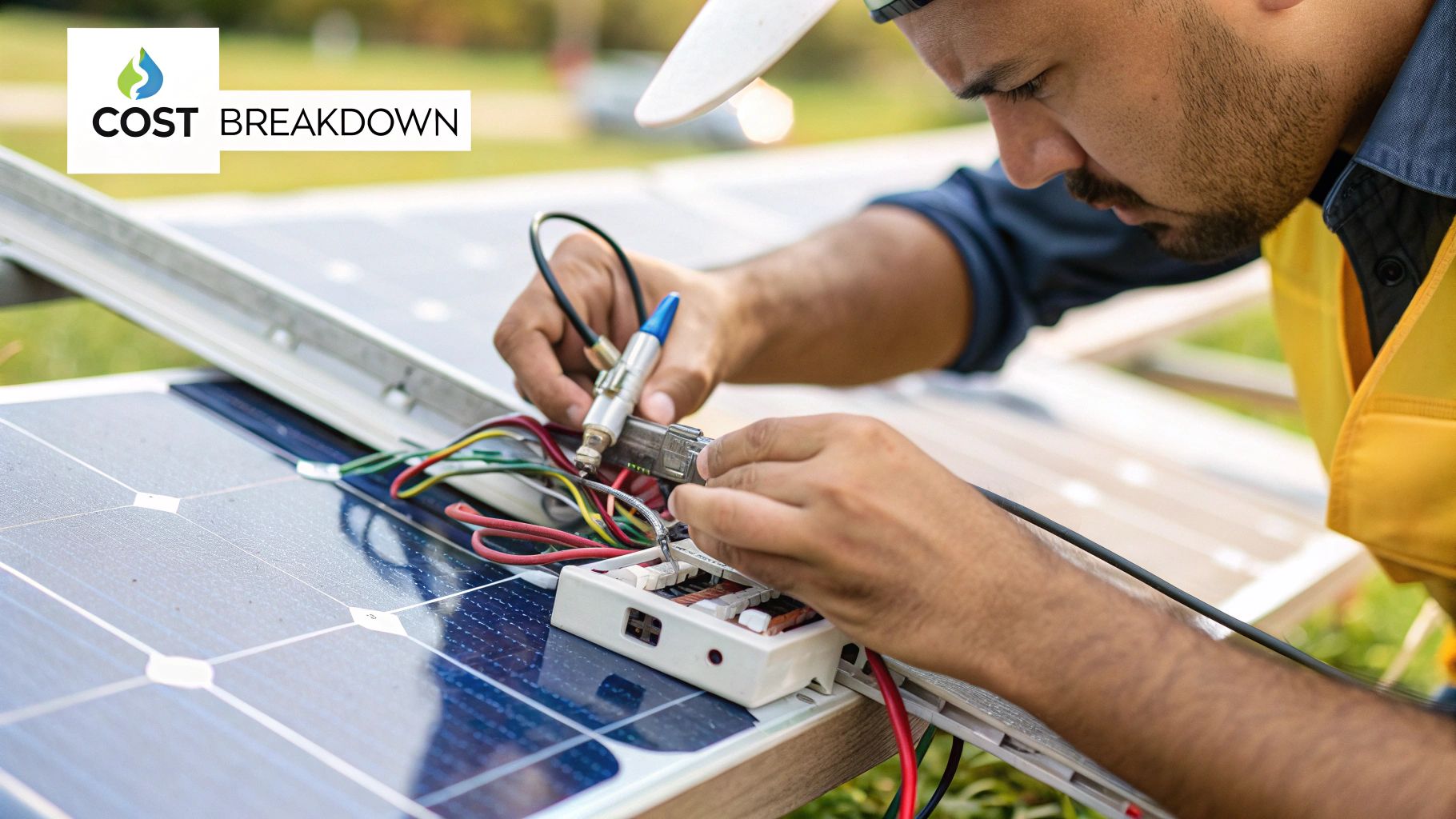
Why Professional Labor is an Investment, Not an Expense
The biggest soft cost you'll see is almost always the installation labor. It can be tempting to look for the cheapest crew, but this is one area where you absolutely don't want to cut corners. Hiring certified, experienced installers is critical. It’s what guarantees your system runs safely, performs at its peak, and keeps the manufacturer warranties on your expensive gear intact.
Hiring a qualified team protects your investment. A shoddy installation can cause roof leaks, create serious electrical hazards, and cripple your energy production, ending up costing you way more in repairs and lost savings than you'd ever save on a cheap install.
Think of it this way: professional labor isn't just about bolting panels to a roof. It's about the expertise to mount everything securely against wind and weather, wire the system to meet strict electrical codes, and seamlessly integrate it with your home's main electrical panel. This is highly specialized work, not a weekend DIY job.
Navigating the Maze of Permits and Inspections
Long before the first panel goes up, your solar company has to wade through a mountain of paperwork. This means getting permits from your local city or county and, just as important, getting the green light from your utility company to connect to the grid. None of this is free, and it all adds to the final price tag.
The time and money involved in permitting can be wildly different from one town to the next.
- Local Building Permits: Your city's building department has to sign off on the structural and electrical plans to make sure everything is up to code and safe.
- Utility Interconnection Agreements: The power company needs to review and approve your system's design before you can officially connect and take advantage of programs like net metering.
This red tape adds both time and cost to the project. An installer in one city might have a quick, low-cost permitting process, while another just a few miles away could face long delays and steep fees. Knowing this helps you set realistic expectations for your project.
For a closer look at what this involves, you can learn more about specific solar panel permit requirements in this detailed guide. Ultimately, these soft costs are a necessary part of making sure your solar installation is legal, safe, and ready to go.
How Your Location Shapes Solar System Costs
It's a common surprise for homeowners, but the very same solar panel system can have a wildly different price tag in one state compared to another. Even neighboring towns can see a shift. Just like real estate, location is a huge driver of the final cost of a solar panel system, and it all comes down to local market conditions.
Several geographic factors are working behind the scenes. The big ones are local labor rates, how much of a headache the permitting process is, and even the amount of sun you get. A state with higher wages and a mountain of permit paperwork is naturally going to have higher installation costs than a place with lower labor costs and a simple, straightforward process.
Regional Cost Drivers
Think of a solar quote as a unique recipe for your specific address. Understanding these local ingredients helps you make sense of the final number.
- Local Labor Rates: The cost to hire certified electricians and installers isn't the same everywhere. You'll almost always pay more for labor in a major city than you would in a rural area.
- Permitting and Inspection Fees: Some towns make it easy with low-cost, over-the-counter permits. Others have a complicated, expensive bureaucratic maze you have to navigate. Those fees get passed directly into your project's total cost.
- Solar Irradiance: This is just a fancy term for how much sunlight your area gets. A sunny state like Arizona can get the job done with a smaller, less expensive system, while a cloudier place like Washington might need a larger, more expensive setup to generate the same amount of power. We dive deep into this in our guide on what direction solar panels should face.
- State and Local Incentives: We'll get into the details on incentives later, but a state with great rebates can completely change the financial picture for solar, which in turn affects overall market demand and pricing.
The Bigger Picture: Global Trends Meet Local Realities
While all those local details matter, they're happening within a much larger global market. The baseline cost of the panels and inverters themselves is set by global manufacturing and technology trends. Luckily, constant innovation and massive-scale production have sent the price of solar equipment plummeting worldwide.
A recent analysis from BloombergNEF found that the cost of electricity from new large-scale solar farms dropped an incredible 21% globally in just one year. This was driven partly by a surplus in solar module production, which pushed hardware prices to record lows.
This is fantastic news for anyone considering solar. But the price you actually pay is always a mix of these low global hardware prices and your specific local "soft costs"—the labor, permits, and other regional expenses.
This chart gives you a quick look at how the average cost-per-watt can swing from one state to the next, showing just how much these local factors matter.
graph TD
subgraph Average Cost Per Watt by State (Before Incentives)
A[Arizona] --> B[$2.45 - $3.20]
C[California] --> D[$2.80 - $3.65]
E[Florida] --> F[$2.40 - $3.15]
G[Massachusetts] --> H[$3.10 - $3.90]
I[Texas] --> J[$2.50 - $3.25]
end
Note: These are estimates and can vary based on your specific location and installer.
At the end of the day, your zip code adds the final layer of costs and savings on top of the base equipment price. It's a critical piece of the solar puzzle you can't ignore.
Finding Savings with Incentives and Tax Credits
That first number you see on a solar quote can give you a bit of sticker shock. I get it. But it's important to remember that the initial price is almost never what you'll actually pay out of pocket.
Think of it like the sticker price on a new car—it’s just the starting point before all the rebates and discounts kick in. A whole host of powerful financial incentives are out there specifically designed to bring the real cost of a solar panel system way down. These programs are what turn a big purchase into a smart, manageable investment.
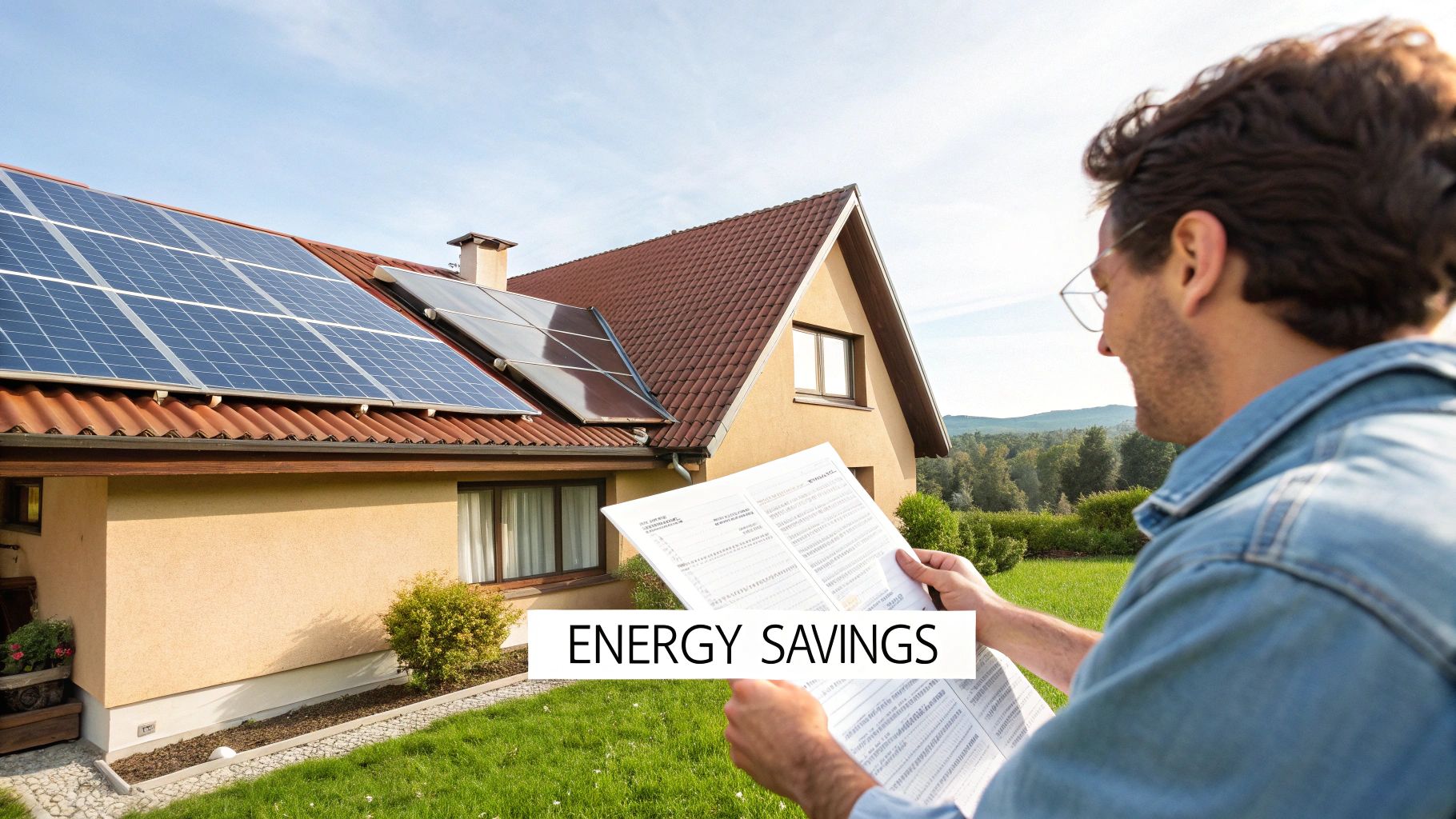
The Federal Solar Investment Tax Credit (ITC)
The biggest and most important incentive for nearly every homeowner in the U.S. is the federal solar Investment Tax Credit, or ITC. This isn't just a simple deduction from your income; it's a powerful, dollar-for-dollar credit that directly slashes what you owe in federal taxes.
Right now, the ITC lets you claim 30% of the total cost of your entire solar project. That covers everything—the panels, inverters, labor, and even a battery storage system if you decide to add one.
Let's run the numbers. Say your total system cost is $30,000. The federal ITC gives you a $9,000 tax credit. Just like that, your effective cost drops to $21,000. It's a massive saving that completely changes the financial picture of going solar.
Exploring State and Local Incentives
The savings don't stop at the federal level. Many states, cities, and even local utility companies have their own programs to sweeten the deal even more. These incentives can look very different depending on where you live, but they usually come in a few common flavors.
- State Tax Credits: Think of this as a bonus. Some states offer their own tax credits that you can stack right on top of the federal ITC for an extra layer of savings.
- Cash Rebates: This is money straight back in your pocket. Certain states or utilities offer upfront cash rebates based on your system's size, which directly lowers your initial investment.
- Performance-Based Incentives (PBIs): In some areas, you can actually earn money for the solar energy your system produces. These payments usually continue for several years, creating a nice little revenue stream.
The real magic happens when you start combining these programs. A $30,000 system could get a $9,000 federal credit and then a $1,000 state rebate on top of that. Suddenly, the final net cost is down to just $20,000—a full third off the original price. Doing a little homework on your local incentives is one of the most important steps to understanding what you'll truly pay for solar.
Understanding Your Solar Payback Period and ROI
When you're looking at the price of a solar panel system, it's easy to focus only on the upfront cost. But the real story, and the most exciting part, is about the long-term financial payoff. Thinking about your system's payback period and Return on Investment (ROI) helps you see it for what it truly is: not just a home improvement, but a powerful financial asset.
The solar payback period is simply the amount of time it takes for the money you save on electricity to completely cover the initial cost of your system. It's the moment your investment breaks even and starts generating pure profit. For most homeowners across the U.S., this tipping point happens somewhere between 8 and 12 years.
The ROI Calculation
So, how do you figure out when you'll hit that breakeven point? It really boils down to three core numbers.
- Your Net System Cost: This isn't the sticker price. It's the total cost after you subtract all the valuable incentives you qualify for, especially the big federal tax credit. For example, a $30,000 system with a 30% tax credit brings your actual cost down to $21,000.
- Your Annual Energy Savings: This one's pretty straightforward. Just look at how much your system will slash from your utility bills over a year. If you're wiping out a $150 monthly bill, that's a solid $1,800 back in your pocket annually.
- Doing the Math: Now, just divide your net cost by your annual savings. Using our example, you'd take $21,000 and divide it by $1,800, which gives you a payback period of 11.7 years. From that day forward, every bit of energy your panels produce is pure savings.
This is a great back-of-the-napkin calculation to get you started. For a deeper dive that accounts for more variables, using an online solar savings calculator can give you a much more precise picture.
The chart below gives you a clear visual of how those savings stack up year after year, eventually overtaking the initial investment.
Your solar ROI is the measure of total profit your system generates over its entire life, shown as a percentage of what you first paid. Since panels are built to last 25 years or more, it’s not uncommon to see a total ROI well over 200%.
Want to see what this looks like with your own numbers? For a personalized projection, jump over to our solar return on investment calculator and plug in your details.
Answering Your Top Questions About Solar Costs
Even after running the numbers, a few practical questions always seem to pop up. Let's tackle some of the most common uncertainties homeowners have when they're figuring out the true cost of a solar panel system.
Does A Larger Solar System Cost Less Per Watt?
That’s a great question, and the answer is yes. It might sound counterintuitive, but bigger systems almost always have a lower cost-per-watt.
Think of it like buying in bulk. Certain costs—like pulling permits, creating the design, and getting the crew to your house—are pretty much fixed. Spreading those fixed costs over more panels brings the average price for each unit of power down. So while the total ticket price is higher, you're getting more bang for your buck with each panel you add.
How Does A Solar Loan Affect The Total Cost?
Taking out a solar loan is a classic trade-off: you get affordability now in exchange for a higher total cost later. The interest you pay over the life of the loan (usually 10 to 25 years) can add a significant chunk to the initial price—often 20-30% or more.
But here's the smart way to look at it: a good solar loan is structured so your monthly payment is less than what you used to pay the utility company. This means you start saving money from the very first month, even while paying off the loan. It's all about making the investment manageable without a huge upfront payment.
Expert Insight: Don't just look at the interest rate. The real test of a good solar loan is whether your new monthly payment is lower than your old electric bill. If it is, you have positive cash flow from day one.
Is A Solar Battery Worth The Extra Cost?
Ah, the battery question. Adding a battery can easily tack on $10,000 or more, so it's a big decision. Whether it's worth it really boils down to your specific situation and what you want to achieve.
A battery makes perfect sense if you're looking for:
- Backup Power: This is the big one. If you can't stand the thought of being without power during an outage, a battery is your best friend.
- Rate Optimization: Some utilities charge sky-high prices for electricity during peak hours (like late afternoons). A battery lets you store your free solar energy from midday and use it during those expensive periods, outsmarting the utility's rate structure.
- Net Metering Workarounds: If your utility offers lousy credit for the extra energy you send back to the grid, a battery lets you keep that power for yourself to use at night.
On the other hand, if your grid is reliable, your main goal is simply a lower electric bill, and your utility has a solid net metering program, you might find that a battery is an expensive luxury you don't really need.
Ready to get a clear, personalized quote for your own home? The team at Radiant Energy can design a system that fits your budget and energy goals. Get your free solar estimate today!

